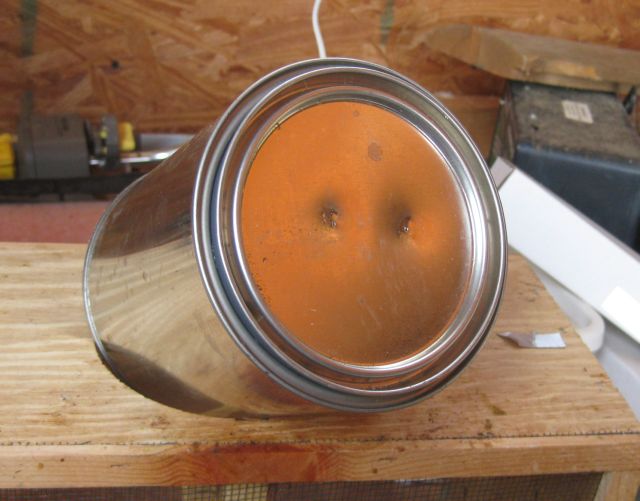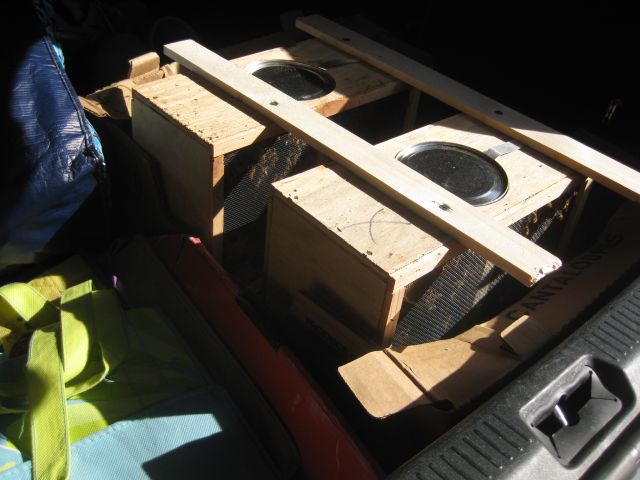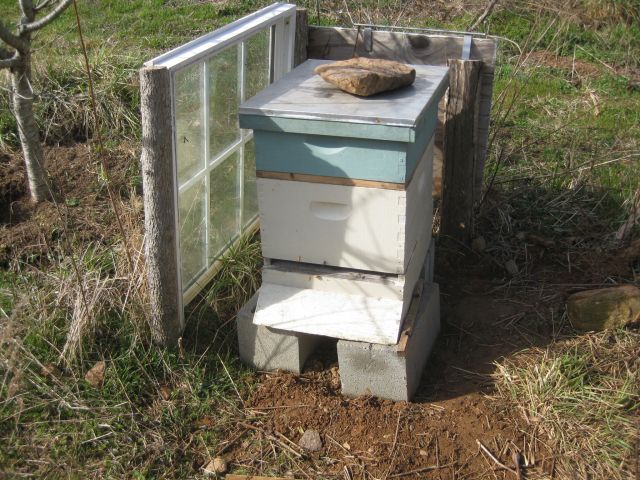9am March 8, Sunday, was the big day. The #2 packages would be available and I had ordered two (cost $78 each). A package is a small wooden box which contains a lot of bees, a mated queen bee in a small cage, and a tin of sugar syrup.

The syrup can has small holes in the removable top through which the contents are delivered to the supping bees.

Sunday was a lovely day although 9am new daylight savings time meant an early start to be at the pickup point. BJ our local professional beekeeper arrived shortly after 9am in his flat bed truck at the back of which, covered in tarps were at least 100 packages. After removing the tarps he studied the outer cages and determined that a couple of them had chilled occupants. He started his truck, switched on the cab heater and placed these packages in the cab. The rest of the packages were ready to go. They are held together with long strips of wood and with a large pruning shear he snipped off 2 packages for me. Italian queens he told me as I headed for my car.
Since there were some bees on the outside of the packages I placed them in the trunk.

The two bee hives were ready, my epipen kit was close at hand and I had prepared bee syrup (sugar water 50:50 ratio), so I donned my bee jacket and carefully carried the first package to the awaiting hive. There are usually 10 frames but I was using 9 of which 4 had drawn comb. The reason for using 9 frames was to leave space for the queen’s cage which is small probably 2″ by 1″ by 1″ and contains the queen and her attendants and would be surrounded by 2 frames with drawn comb on each side.
For this procedure gloves are too clumsy. The bees were noisy but I sprayed them with syrup and they instantly quieted down licking the sugar water off themselves. I removed 4 frames so there was space to work. I removed the syrup can and then the queen cage which was covered with bees and was attached to a foil strip. At the top of the cage is a cork which you remove and beneath it is a marshmellow mixture which you leave. I screwed the strip into the top of a wooden frame so the queen’s cage was positioned with the gauze side facing the center. While I was doing this there were bees peacefully crawling all over my hands. Then with the queen cage in position I upturned the package and poured the bees into the hive. Some remained in the package and I placed the package at the hive entrance for them to find their way home. I replaced the 4 frames gently then placed a top feeder on the frames and covered the hive. The process was uneventful.
The installation of the second package should have been easier but I let the queen cage slip to the bottom of the package and then had to reach down among 10 thousand bees to find it and bring it out (not recommended, I should have fished it out with long nose pliers). It was warming up and bees don’t like perspiration and with bees all over my hand as I was screwing down the cage strip I must have squeezed one, so I was rewarded with a sting. But they were remarkably peaceful being young bees without honey stores to protect.
Both hives were voraciously hungry and I replenished their food the following morning. Now they are out and about and a few have found food tho most are just reveling in the good weather and orienting themselves.

In a couple days I will check on the hives. By then the bees should have eaten through the marshmellow and released the queen and I hope to see, if not the queen and her attendants, then a good laying pattern of eggs.
